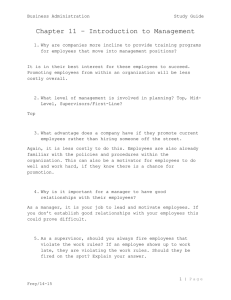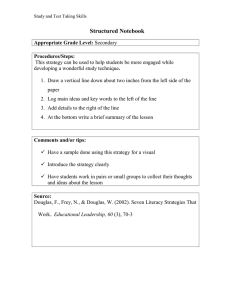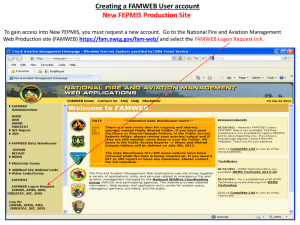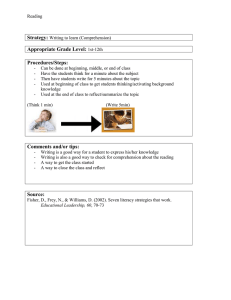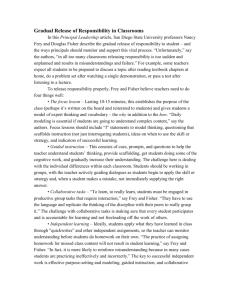Prospects for Gravitational-Wave Observations with Advanced LIGO
advertisement
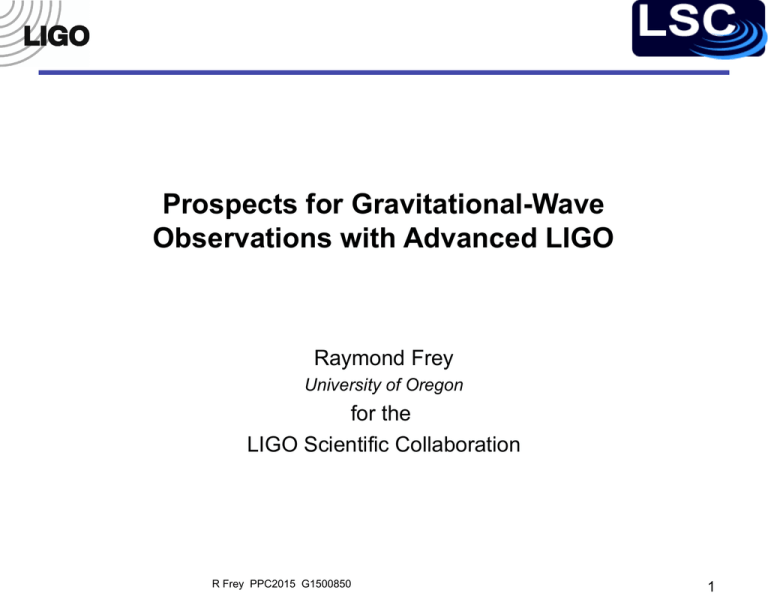
Prospects for Gravitational-Wave Observations with Advanced LIGO Raymond Frey University of Oregon for the LIGO Scientific Collaboration R Frey PPC2015 G1500850 1 Outline • Introduction to GW detection with LIGO • Advanced LIGO • Prospects for detection of compact binary mergers • Science with advanced detectors – a few examples relating to PPC Direct detection of GW from inflation? Precision Hubble relation R Frey PPC2015 G1500850 2 GWs in GR R Frey PPC2015 G1500850 3 Evidence (indirect) for Gravitational Waves Taylor and Hulse: Pulsar observed for 25 years: ←300 million years from now R Frey PPC2015 G1500850 4 Evidence (indirect) for Gravitational Waves ?? BICEP2 Nope… Not yet. R Frey PPC2015 G1500850 5 Required GW Sensitivity for Detection • GW emission requires time varying quadrupole moment of mass distribution: binary NS/BH as standard source. • Gravitational-wave strain, h = δL/ L, is the analog of the radiation field E in E&M • Strain estimate: R Frey PPC2015 G1500850 6 GW Interferometer principle • • • • • • Michelson interferometer with Fabry-Perot cavity arms. End mirrors are pendula ⇒ Freely falling test masses Long baseline: 4 km ( h = δL/ L ) - For h ≈10-21, L ≈ 1 km, then δL ≈ 10-18 m Fabry-Perot Cavity storage time ∼1 ms (∼100 bounces) Power recycling (x30) Noise estimate: 5W R Frey PPC2015 G1500850 7 Antenna Pattern GWs are transverse, with x and + polarizations: hx(t) , h+(t) “×” polarization Detector response “+” polarization RMS sensitivity h(t) = Fx hx(t) + F+ h+(t) R Frey PPC2015 G1500850 8 Current GW interferometer facilities LIGO! 4 km! GEO 600m! Virgo 3 km! LSC: LIGO +GEO LIGO! 4 km! R Frey PPC2015 G1500850 9 LIGO observatories • 1.2 m diameter vacuum tube • Aligned to a mm • Total of 16km fabricated with no leaks • 1 nTorr R Frey PPC2015 G1500850 10 iLIGO → aLIGO After several years of data taking at iLIGO design sensitivity: • Lots of experience and many upper limits • No GW detections ⇒ Make the detectors (yet) more sensitive! R Frey PPC2015 G1500850 11 Advanced LIGO LIGO S5 2006 S6 2007 Virgo VS R1 2008 2009 R2 2010 Adv LIGO GEO HF R3 2011 2012 2013 2014 2015 Adv Virgo Install Advanced LIGO Advanced LIGO • Major upgrades Lasers, optics, suspensions Limited by Quantum noise 10-22 • 10x better sensitivity • 1000x bigger search volume 10-23 • 1st Advanced LIGO observational run Sep-Dec 2015 10-24 R Frey PPC2015 G1500850 12 New hardware installed (suspensions here) R Frey PPC2015 G1500850 13 Advanced LIGO as a quantum system • LIGO is a Heisenberg microscope • Mirror position (x) – given by the E field phase and the momentum kick of the mirror (p) due to radiation pressure are fundamentally connected by quantum mechanics: In the quantum optics description: • x → phase (shot) noise • p → amplitude (radiation pressure) noise R Frey PPC2015 G1500850 14 The canonical LIGO GW target: Compact binary coalescence • NS-NS known to exist – predicted rate • ~1% of Mc2 into GWs • aLIGO range 200-400 Mpc for NS-NS arXiv: 1003.2480 , CQG, (LSC, Virgo) R Frey PPC2015 G1500850 15 Short GRB and binary merger rates • Short GRB rate of 8-30 per Gpc3 per year (from Guetta and Piran, Astron.Astrophys, 2006) • Expected NS-NS and NS-BH rates from Aasi et al, CQG, 2010 Broadly consistent for gamma-ray burst opening angles in expected 10-20 deg range Clark, et al arXiv:1409.8149 R Frey PPC2015 G1500850 16 Possible Advanced LIGO Run Plan, ca 2014 aLIGO design NS-NS merger detections (predicted) 3rd science run, 2017-18? 2nd aLIGO science run, 2016-17? S5/S6 1st aLIGO science run, Aug 2015 Sep 2015 17 R Frey PPC2015 G1500850 aLIGO: ramping up BNS range (Mpc, average) LIGO Hanford LIGO Livingston ER7, June 2015 (100 kW of 750 kW) Note: max BNS range for iLIGO was 20 Mpc R Frey PPC2015 G1500850 18 Connections to PPC • Particle Physics Neutron star EOS from binary NS mergers – nuclear matter at extreme density; quark matter? Nearby (~galactic) core-collapse supernova – neutrino physics? • Cosmology Density of binary NS and light black holes (< few hundred M) Direct detection of GWs from inflation? Tracing cosmological expansion at low redshift R Frey PPC2015 G1500850 19 Connections to PPC • Particle Physics Neutron star EOS from binary NS mergers – nuclear matter at extreme density; quark matter? Nearby (~galactic) core-collapse supernova – neutrino physics? • Cosmology Density of binary NS and light black holes (< few hundred M) Direct detection of GWs from inflation? Tracing cosmological expansion at low redshift R Frey PPC2015 G1500850 20 Search for cosmological GW background LIGO upper limit, Nature (2009) aLIGO expected Upper Limit Boyle & Buonanno r = 0.2 Barnaby, et al; Cook & Sorbo Mandic, et al R Frey PPC2015 G1500850 Looks hard! 21 “standard sirens” and cosmology Binary inspiral system: (lowest PN order) “chirp” mass • Redshifted chirp mass is accurately measured from phase evolution • Therefore, the amplitude directly determines luminosity distance • Note that the redshift is not directly measured • Schutz (1986) pointed out that that, with a corresponding measurement of z, these GW “standard sirens” could be used to make a measurement of the Hubble parameter which is independent of the EM distance ladder R Frey PPC2015 G1500850 22 Role of precision H0 • Advanced GW detectors can measure sirens “only” to z ~ 0.2 Measurement of H0 (i.e. H(z) for small z) • Is this relevant for cosmology? • First: Testing the EM distance ladder is important (Can it provide constraints on alternative gravity?) • With enough events (N), can determine H0 precisely Dalal,Holz,Nissanke Claim error on H0 ~ [3-5%](10/N)0.5 • A ~1% measurement at small z is cosmologically sensitive: • H0 + CMB R Frey PPC2015 G1500850 23 Hubble and Dark Energy Sensitivity To gauge the sensitivity to the DE EOS, Dalal et al calculated the error on H0 and w as a function of the number of BNS events. Assumptions: • 1% CMB Ωmh2 • flat universe • w constant [Planck] R Frey PPC2015 G1500850 24 Future role of precision H0 • w(a) and DE FOM Weinberg, et al. 2012 a = 1/(1+z) • From Weinberg et al. (2012): Assuming a w0 − wa model for dark energy, a 1% H0 measurement would raise the DETF Figure of Merit by 40% A precise determination of H0, coupled to a w(z) parameterization that allows low-redshift variation, could … definitively answer the basic question, “Is the universe still accelerating?” R Frey PPC2015 G1500850 25 EM counterparts of NS-NS/NS-BH mergers • Need redshifts to measure H0 • Requires independent EM observation of the astrophysical event • Two possibilities: short GRB • provides space-time coordinates for GW search • Allows for EM followup z follow-up of GW trigger • e.g. off-axis GRB afterglow or isotropic kilonova afterglow • LSST will be ideal • Follow-up of GW sources requires good localization on the sky R Frey PPC2015 G1500850 26 EM counterparts of NS-NS/NS-BH mergers Short GRB Berger & Metzger Metzger & Berger R Frey2012 PPC2015 G1500850 27 NS-NS mergers, EM afterglows (kilonovae), R-process elements • NS-NS merger remnant acretion disk powers short GRB Shibata • Bombarded by neutron-rich ejecta from the merger • synthesizes heavy nuclei (competes with supernovae) • decays make isotropic EM afterglow (a target for EM followup obs) – “kilonovae” e.g. Metzger, et al Shibata R Frey PPC2015 G1500850 28 forging the lanthanides ~ 0.1 solar mass of hot, dense, neutron-rich ejecta • kT > 1 MeV • ρ ~ 108-1012 g cm-3 Fissions and decays to Co, Ni, which then decay over days afterglow R Frey PPC2015 G1500850 29 kilonova evidence R Frey PPC2015 G1500850 30 EM Followups • We have enlisted (via an MOU process) observing partners to do follow ups • Had some practice with this in the last months of iLIGO running (Aug-Sept 2010) R Frey PPC2015 G1500850 Astron Astrophys 539 (2012) A124 Astron Astrophys 541 (2012) A155 arXiv:1205.1124 31 The 2nd generation GW detector network LIGO (4km) 2015 GEO (0.6km) now Virgo (3km) 2016 Kagra (3km) ~2018 LIGO-India (4km) ~2022 Sky maps R Frey PPC2015 G1500850 32 Moving one LIGO detector to India Determination of source sky position: NS-NS binary inspirals LIGO-Virgo LIGO-Virgo + LIGO India Fairhurst et al., arXiv:0908.2356; 1010.6192; 1205.6611 R Frey PPC2015 G1500850 33 Summary • A comprehensive gravitational-wave observing campaign with advanced interferometric detectors is about to begin • No GW detections with initial LIGO, but much progress Learned how to improve detectors Learned how to analyze GW data and say a little about astrophysics Forged partnerships and collaborations (ongoing) • To take full advantage of likely GW detections and the full science opportunity presented by these sensitive instruments, an emerging field of GW astronomy has spun up • With Advanced LIGO (aLIGO) there is promise to make significant advances in GR and gravity tests, astrophysics, and (maybe) cosmology Exciting Time! R Frey PPC2015 G1500850 34 Targeting a centennial… • 1915 Einstein paper: Got the field equations into final form. • 1916 Einstein paper: Definitive GR paper: theory in final form; described the success for the perihelion advance of Mercury • 1917 Einstein paper: Cosmological consequences of GR • 1918 Einstein paper: Prediction of gravitational waves R Frey PPC2015 G1500850 35 Additional slides… R Frey PPC2015 G1500850 36 GRB 070201 • Short-duration GRBs are thought to be predominantly due to NS-NS or NS-BH mergers • GRB 070201 – a short-duration gamma-ray burst with position consistent with M31 (Andromeda), 0.8 Mpc away. • Such a nearby GRB would have easily been observed by LIGO if due to a binary merger • This hypothesis ruled out ~99% CL [Astrophys. J. 681 (2008) 1419] Revised error box • Most likely: SGR in M31 Mazets et al., ApJ 680, 545 (Eiso~1045 erg) • Similar result for GRB 051103 in M81 (5 Mpc) ApJ 755 (2012) 2 R Frey PPC2015 G1500850 37 Beating the Crab Spindown Limit • Crab pulsar is spinning down • How much of the spindown power is going into GWs? • ≤ 2% : ApJ 683 (2008) Also achieved for Vela pulsar Getting close to spindown limit on other known pulsars (ApJ 713 (2010) 671 ) R Frey PPC2015 G1500850 38 GW signals classification un-" modeled" matched filter" Short duration" Long duration" Burst search" Stochastic search" Inspiral search" CW search" Credit: NASA/CXC/ASU/J. Hester et al." R Frey PPC2015 G1500850 39
